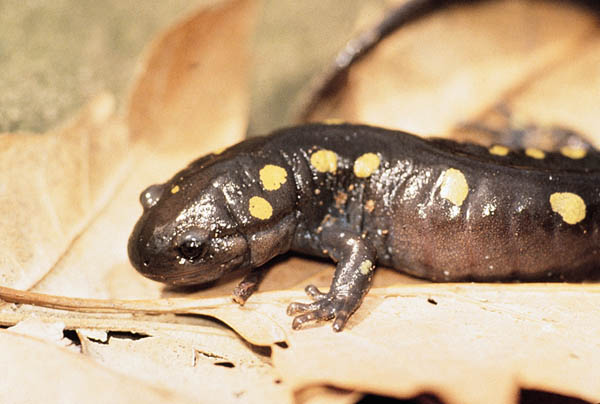- Spotted Salamander
Taxobox
name = Spotted Salamander
status = LC
status_system = iucn3.1
trend = stable

image_width = 250px

image2_width = 150px
regnum =Animal ia
phylum = Chordata
classis =Amphibia
ordo =Caudata
familia =Ambystomatidae
genus = "Ambystoma"
species = "A. maculatum"
binomial = "Ambystoma maculatum"
binomial_authority = (Shaw,1802 )The Spotted Salamander ("Ambystoma maculatum") is a
mole salamander common in the easternUnited States andCanada .Description
A salamander that can be 4-7 inches long and has yellow spots on its
dorsal surface, though some specimens have no spots at all. Their primary habitat are deciduous forests with fish-free ponds or vernal pools for egg laying and larval development. They feed primarily on invertebrates likeearthworm s andslug s also they will eat almost any insect they can get. They are primarily subterranean, though can be found beneath surface debris on cool, damp days.The species was first described byGeorge Shaw in 1802 in his "General Zoology or Systematic Natural History". It is the State Amphibian ofSouth Carolina .Breeding
This species begins to mate as soon as the snow melts in March or April. The adults follow creeks in their migration to temporary or permanent pools of water which are free of predatory fish. Adults breed in the same pond throughout their lifetime, with females laying 25 to 200 eggs in compact masses of jelly attached to underwater plants. The eggs take 31 to 54 days to hatch, depending on temperature. Once the larvae emerge, they require an additional 61 to 110 days before they leave the pond.
Habitat
Spotted Salamanders prefer mature, moist woodlands with access to
vernal pools for breeding. They spend most of the year in underground burrows, but are sometimes found under rotting logs or leaf litter. They are also found amongst rocks, in the roots of a growing tree on the side of a hill, and in dark rock mounds. They prefer dark moist areas to live. Small invertebrates, such as worms, insects, spiders, slugs, and snails are eaten.Distribution
Its distribution ranges from central and southern
Ontario ,Nova Scotia ,Prince Edward Island , mainlandNew Brunswick and south through the United States to theGulf of Mexico . This species is widespread throughout theGreat Lakes region and is found as far north as Sudbury.Mutualism
Eggs of "A. maculatum" can have a
symbiotic relationship with agreen alga , "Oophila amblystomatis ". [http://www.biolbull.org/cgi/content/abstract/115/3/483] [http://www.hsu.edu/content.aspx?id=5910] Jelly coating prevents the spotted salamander eggs from drying out, however it inhibitsoxygen diffusion (required forembryo development). The "Oophila" algaphotosynthesize s and produces oxygen in the jelly. The developing salamander thus metabolizes the oxygen, producingcarbon dioxide (which then the alga consumes).They are also saprophytes.References
* Database entry includes a range map and a brief justification of why this species is of least concern
External links
* [http://calphotos.berkeley.edu/cgi/img_query?stat=BROWSE&query_src=photos_fauna_sci-Amphibian&where-lifeform=Amphibian&where-taxon=Ambystoma+maculatum&title_tag=Ambystoma+maculatum Ambystoma maculatum] at CalPhotos
* [http://animaldiversity.ummz.umich.edu/site/accounts/information/Ambystoma_maculatum.html Ambystoma maculatum: Information] at ADW
*eol|17203903
Wikimedia Foundation. 2010.
